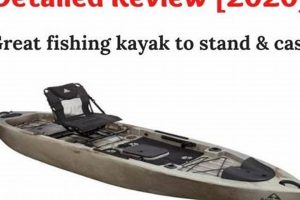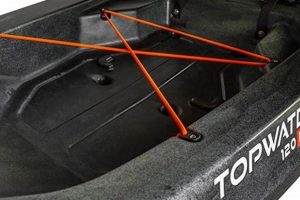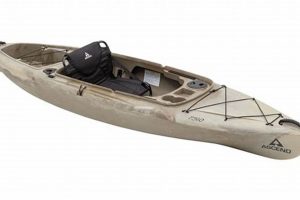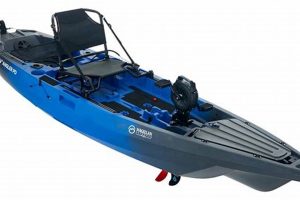Selecting appropriate vessels for angling requires careful consideration of various factors. High-quality manufacturers in this niche prioritize stability, durability, and specialized features like rod holders, storage compartments, and comfortable seating designed for extended periods on the water. Examples include designs optimized for specific fishing styles, such as those for stillwater angling versus navigating currents or ocean environments.
Investing in a reputable product from a well-regarded manufacturer often translates to enhanced safety, improved fishing performance, and greater longevity. Historically, anglers relied on traditional boats or less specialized kayaks. However, the development of purpose-built kayaks designed for fishing has significantly improved the angler’s experience, offering improved maneuverability, access to shallow waters, and a more intimate connection with the environment. This specialization has led to a surge in popularity within the fishing community.
This article will delve into various aspects of selecting the right vessel for specific fishing needs, covering topics such as hull design, materials, essential features, and prominent manufacturers in the industry. This information empowers informed purchasing decisions and facilitates more enjoyable and productive angling experiences.
Tips for Selecting a Fishing Kayak
Choosing a suitable fishing kayak requires careful evaluation of individual needs and preferences. Several key considerations can significantly impact on-water performance and overall satisfaction.
Tip 1: Consider Hull Design: Different hull designs offer varying levels of stability, speed, and maneuverability. A pontoon-style hull offers exceptional stability, while a V-shaped hull provides better tracking and speed in open water.
Tip 2: Evaluate Material Construction: Kayaks are typically constructed from polyethylene, fiberglass, or composites. Polyethylene offers durability and affordability, while fiberglass and composites provide enhanced performance and lighter weight.
Tip 3: Prioritize Comfort and Ergonomics: A comfortable seat, adjustable footrests, and ample legroom are crucial for extended fishing trips. Consider adjustable backrests and features like thigh braces for enhanced support.
Tip 4: Assess Storage Capacity: Adequate storage space for tackle, gear, and personal items is essential. Consider built-in compartments, tank wells, and bungee cords for securing equipment.
Tip 5: Examine Rod Holders and Mounting Options: Dedicated rod holders and mounting options for fish finders and other accessories enhance fishing functionality. Consider flush-mounted rod holders for trolling and adjustable mounts for electronics.
Tip 6: Factor in Weight and Portability: The kayak’s weight and size will impact transportation and storage. Consider lighter models or those with integrated wheels for easier handling.
Tip 7: Research Manufacturer Reputation: Reputable manufacturers often offer better warranties, customer support, and readily available replacement parts.
By carefully considering these factors, anglers can select a kayak optimized for their individual fishing style, enhancing both comfort and performance on the water. An informed decision translates to a more productive and enjoyable fishing experience.
By understanding these key elements, anglers can confidently navigate the market and choose a kayak that aligns perfectly with their individual fishing style and preferences, leading to greater success and enjoyment on the water. This careful selection process culminates in a rewarding investment that supports countless future fishing adventures.
1. Reputation
A manufacturer’s reputation significantly influences consumer perception and purchasing decisions regarding fishing kayaks. A strong reputation often stems from a consistent track record of producing high-quality, durable, and well-designed products. Positive customer experiences, including reliable performance on the water, effective customer service, and robust warranty support, contribute to a positive brand image. Conversely, a negative reputation, perhaps arising from frequent product defects, poor customer service, or safety concerns, can severely impact a brand’s market share and future prospects. For example, a company known for readily addressing warranty claims and offering excellent product support will likely garner a stronger reputation than one with a history of unresolved customer issues. This direct link between customer experience and brand perception underscores the importance of reputation in the fishing kayak market.
Practical implications of reputational strength extend beyond initial purchase decisions. A well-regarded brand can command higher resale values, reflecting consumer confidence in the product’s long-term durability and performance. Furthermore, a positive reputation often fosters trust, making consumers more likely to consider other products offered by the same manufacturer. This brand loyalty represents a significant asset in a competitive market. Conversely, a damaged reputation can lead to decreased consumer trust, requiring substantial effort and investment to rebuild brand image and regain market confidence. The long-term effects of reputation underscore its critical role in the overall success of a fishing kayak brand.
In summary, reputation acts as a powerful indicator of quality and reliability within the fishing kayak market. Consumers often rely on a brand’s reputation as a key factor in their purchasing decisions, associating a strong reputation with enhanced durability, superior performance, and reliable customer support. This connection highlights the crucial role reputation plays in building consumer trust and establishing long-term brand loyalty. Understanding this dynamic allows for more informed purchasing decisions and contributes to a more positive overall experience for anglers.
2. Durability
Durability represents a critical factor in evaluating fishing kayak brands. A kayak’s ability to withstand harsh environmental conditions, impacts, and regular wear-and-tear directly impacts its lifespan and overall value. Durable kayaks require less frequent repairs and replacements, reducing long-term costs and ensuring more time on the water. Construction materials, manufacturing processes, and design features contribute significantly to a kayak’s overall durability. For example, kayaks constructed from high-density polyethylene exhibit greater resistance to impacts and abrasion compared to those made from less robust materials. Similarly, reinforced hulls and decks can better withstand stress and strain, contributing to increased longevity. The ability to resist UV degradation, particularly in regions with intense sunlight, also represents a crucial aspect of durability. Exposure to UV radiation can weaken kayak materials, leading to cracking and premature failure. Manufacturers employing UV-resistant materials and coatings demonstrably enhance product lifespan.
The practical implications of durability extend beyond simply resisting damage. A durable kayak provides a more secure and reliable platform for fishing, allowing anglers to confidently navigate challenging waters and adverse conditions. This enhanced confidence translates to a more enjoyable and productive fishing experience. Furthermore, durability contributes significantly to resale value. Kayaks known for their robust construction and long-lasting performance retain value better over time, making them a wiser investment in the long run. Conversely, kayaks prone to damage or requiring frequent repairs depreciate more rapidly, leading to increased costs and potentially compromising safety on the water. Choosing a durable kayak minimizes these risks, ensuring long-term performance and value retention.
In summary, durability plays a pivotal role in defining a good fishing kayak brand. It represents a significant factor influencing the overall cost of ownership, angler confidence, and long-term value retention. Careful consideration of materials, construction techniques, and manufacturer reputation allows anglers to select kayaks built to withstand the rigors of the fishing environment, ensuring years of reliable service and enjoyable fishing experiences. This understanding emphasizes the direct correlation between durability and value in the fishing kayak market.
3. Innovation
Innovation serves as a key differentiator among fishing kayak brands, propelling the evolution of design and functionality. Manufacturers committed to innovation consistently seek improvements in areas such as hull design, material science, and integrated features. This pursuit of advancement results in kayaks that offer enhanced performance, improved comfort, and greater fishing utility. For example, the introduction of pedal-powered kayaks revolutionized hands-free fishing, while advancements in stability systems provide anglers with more secure casting platforms. Integration of fish-finder technologies and GPS systems further exemplifies how innovation directly enhances the angling experience. Such advancements not only improve on-water performance but also cater to evolving angler needs and preferences, driving market competition and pushing the boundaries of kayak design. Brands prioritizing research and development often introduce features that address specific fishing challenges, leading to more specialized and effective angling platforms.
The practical implications of innovation are readily apparent in the evolution of fishing kayak features. Improved hull designs offer increased maneuverability and speed, allowing anglers to access previously unreachable fishing grounds. Advancements in seating systems and ergonomics enhance comfort during long fishing trips, reducing fatigue and improving overall enjoyment. Furthermore, innovative storage solutions and integrated rigging systems streamline gear management, maximizing efficiency on the water. Consider, for instance, the development of specialized kayak designs for specific fishing styles, such as stand-up fishing or trolling. These tailored designs demonstrate how innovation caters to diverse angling needs, resulting in more effective and enjoyable fishing experiences. The continuous pursuit of innovation ultimately empowers anglers with tools and technologies that enhance their ability to connect with the aquatic environment and pursue their passion for fishing.
In summary, innovation plays a vital role in defining good fishing kayak brands. A commitment to research and development translates to tangible improvements in performance, comfort, and functionality. By embracing innovative solutions, manufacturers cater to the evolving needs of anglers, driving market competition and pushing the boundaries of kayak design. This continuous pursuit of advancement ultimately benefits anglers, providing them with increasingly sophisticated and effective tools for pursuing their fishing endeavors. Understanding the impact of innovation empowers informed purchasing decisions and highlights the importance of supporting brands that prioritize continuous improvement in the fishing kayak industry.
4. Features
Distinguishing features significantly contribute to the definition of good fishing kayak brands. These specialized elements enhance functionality, comfort, and overall fishing performance. Careful consideration of these features empowers informed purchasing decisions aligned with individual angling styles and preferences.
- Rod Holders and Storage
Dedicated rod holders, strategically positioned for easy access and secure rod placement, represent a crucial feature. Multiple rod holders cater to diverse fishing techniques. Ample storage compartments, including dry hatches and tank wells, accommodate tackle, gear, and personal items. Well-designed storage systems optimize space utilization and ensure efficient organization, minimizing clutter and maximizing on-water efficiency. For example, recessed tackle trays within easy reach enhance lure changes and rigging adjustments. Secure storage for rods and reels safeguards valuable equipment during transport and navigation.
- Seating and Comfort
Ergonomic seating significantly impacts comfort, particularly during extended fishing trips. Adjustable seats with ample back support and cushioning minimize fatigue and enhance overall enjoyment. Features like adjustable footrests and thigh braces further customize fit and enhance stability. Elevated seating positions improve visibility and casting range. For example, breathable mesh seating materials enhance airflow and comfort in warm weather. Adjustable backrests accommodate individual preferences and provide crucial support for prolonged periods on the water.
- Stability and Tracking
Hull design dictates stability and tracking performance. Wider hulls generally offer increased primary stability, crucial for casting and landing fish. Longer kayaks typically track straighter, particularly in open water or currents. Specialized hull designs, like those incorporating pontoon elements or multi-chined configurations, cater to specific fishing environments and enhance stability in various conditions. For example, a kayak designed for stillwater fishing might prioritize stability over speed, whereas one intended for ocean use would emphasize tracking and wave handling capabilities.
- Propulsion Systems
Various propulsion systems cater to different angler preferences and fishing styles. Paddle kayaks offer traditional human-powered propulsion, emphasizing maneuverability and affordability. Pedal-powered kayaks provide hands-free fishing, enabling anglers to focus on casting and retrieving. Motorized kayaks offer increased speed and range, facilitating access to distant fishing grounds. For example, pedal drives with forward and reverse capabilities enhance maneuverability in tight spaces, while electric motors extend fishing range and minimize physical exertion in challenging conditions. The choice of propulsion system significantly impacts fishing style and overall experience.
Collectively, these features distinguish good fishing kayak brands, offering anglers specialized tools designed to enhance on-water performance and overall enjoyment. Careful consideration of these features alongside manufacturer reputation, durability, and innovation empowers informed purchasing decisions, aligning kayak selection with individual fishing styles, preferences, and target environments. This comprehensive approach ensures a rewarding investment that supports countless successful fishing adventures.
5. Customer Support
Robust customer support distinguishes reputable fishing kayak brands. Effective support encompasses pre-sales guidance, addressing inquiries and offering product expertise, and post-sales assistance with warranty claims, repairs, and parts replacement. This comprehensive approach builds consumer trust and fosters long-term brand loyalty. Accessibility, responsiveness, and knowledgeable representatives characterize effective customer support. For example, readily available online resources, including FAQs and instructional videos, empower customers with self-service solutions. Prompt responses to inquiries via phone, email, or chat demonstrate a commitment to customer satisfaction. Knowledgeable staff capable of addressing technical questions and troubleshooting issues instills confidence in the brand’s expertise and product quality. A lack of adequate customer support, conversely, can erode consumer trust, leading to negative brand perception and impacting future sales. Delayed responses, unresolved issues, or unhelpful representatives can severely damage a brand’s reputation, particularly in the competitive fishing kayak market.
Practical implications of effective customer support extend beyond immediate problem resolution. Positive customer service experiences contribute to a stronger brand image, fostering customer loyalty and positive word-of-mouth referrals. This organic brand advocacy holds significant value in the digital age, influencing purchasing decisions and driving market growth. Furthermore, customer feedback gathered through support interactions provides valuable insights for product development and improvement. Addressing recurring issues or incorporating customer-suggested features demonstrates a commitment to continuous improvement and strengthens the brand’s reputation for responsiveness. For instance, a company that proactively addresses common customer concerns through design modifications demonstrates a commitment to customer satisfaction and product excellence. This responsiveness differentiates leading brands in the fishing kayak market, contributing to sustained growth and market leadership.
In summary, robust customer support serves as a critical component of good fishing kayak brands. Effective support builds trust, fosters loyalty, and provides valuable feedback for continuous improvement. Accessibility, responsiveness, and knowledgeable representatives characterize exemplary customer service, contributing significantly to positive brand perception and long-term market success. Investing in comprehensive customer support represents a strategic investment in brand building and customer satisfaction, distinguishing reputable manufacturers in the competitive fishing kayak industry.
Frequently Asked Questions
This section addresses common inquiries regarding the selection and ownership of fishing kayaks, providing concise and informative responses to facilitate informed decision-making.
Question 1: How does hull design impact fishing kayak performance?
Hull design significantly influences stability, maneuverability, and tracking. Wider, flatter hulls offer enhanced stability, ideal for calm waters and stand-up fishing. Longer, V-shaped hulls provide better tracking and speed in open water but may sacrifice some stability. Specialized hull designs, such as pontoon hulls or multi-chined configurations, cater to specific fishing environments and styles.
Question 2: What materials are commonly used in fishing kayak construction, and what are their respective advantages?
Polyethylene kayaks are known for durability and affordability. Fiberglass kayaks offer lighter weight and enhanced performance but typically come at a higher price point. Composite kayaks combine various materials for optimized performance characteristics, often prioritizing strength, weight reduction, and durability. Material selection significantly impacts cost, performance, and overall lifespan.
Question 3: What key features should be considered when choosing a fishing kayak?
Essential features include rod holders, storage compartments, comfortable seating, adjustable footrests, and a stable hull design. Additional features like integrated fish finders, GPS systems, and specialized mounting options enhance functionality and cater to specific fishing styles. Feature selection should align with individual angling needs and preferences.
Question 4: How does one determine the appropriate size and weight capacity for a fishing kayak?
Size and weight capacity considerations depend on angler size, gear requirements, and intended fishing environment. Larger kayaks offer increased stability and storage capacity but can be more challenging to transport and maneuver. Weight capacity should accommodate the combined weight of the angler, gear, and potential catch. Careful consideration of these factors ensures safe and comfortable operation.
Question 5: What are the advantages of choosing a reputable fishing kayak brand?
Reputable brands often utilize higher-quality materials, employ advanced construction techniques, and offer better warranty coverage and customer support. A strong reputation signifies a commitment to quality, durability, and customer satisfaction, resulting in a more reliable and enjoyable ownership experience.
Question 6: How does one maintain a fishing kayak to ensure its longevity?
Regular cleaning, proper storage, and timely repairs contribute to a kayak’s lifespan. Rinsing the kayak after each use removes saltwater, debris, and potential contaminants. Storing the kayak in a sheltered location, protected from direct sunlight and extreme temperatures, prevents material degradation. Addressing minor damage promptly prevents further deterioration and ensures long-term structural integrity.
Understanding these key aspects empowers informed purchasing decisions, leading to greater satisfaction and enhanced on-water experiences. Choosing the right fishing kayak significantly impacts fishing success and enjoyment.
For a more detailed examination of specific kayak models and manufacturer offerings, please continue to the next section.
Conclusion
Careful selection from among reputable fishing kayak manufacturers represents a pivotal decision for anglers. Prioritizing key factors such as hull design, material durability, innovative features, and robust customer support ensures a well-informed purchase. Balancing performance characteristics with individual angling styles and target environments optimizes on-water experiences and maximizes long-term value. Understanding the interplay of these elements empowers informed decisions, leading to greater satisfaction and enhanced fishing success.
The evolution of fishing kayak design and technology continues to refine the angling experience. Investing in a high-quality product from a reputable manufacturer represents a commitment to both performance and enjoyment on the water. This careful consideration ensures not only productive fishing excursions but also the long-term durability and value retention of the chosen vessel, supporting countless future adventures in the pursuit of angling passion.






